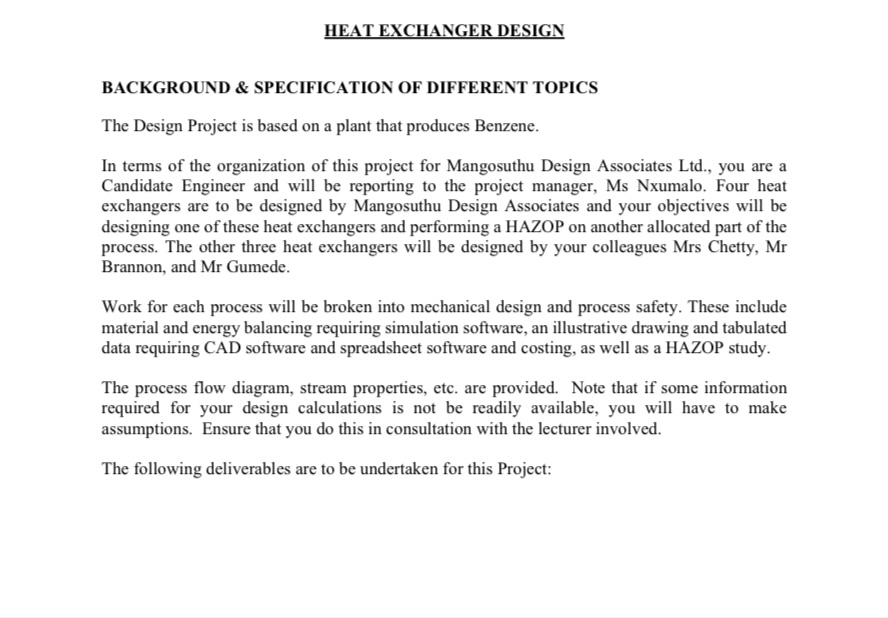Answered step by step
Verified Expert Solution
Question
1 Approved Answer
BACKGROUND & SPECIFICATION OF DIFFERENT TOPICS The Design Project is based on a plant that produces Benzene. In terms of the organization of this project
BACKGROUND & SPECIFICATION OF DIFFERENT TOPICS
The Design Project is based on a plant that produces Benzene.
In terms of the organization of this project for Mangosuthu Design Associates Ltd you are a
Candidate Engineer and will be reporting to the project manager, Ms Nxumalo. Four heat
exchangers are to be designed by Mangosuthu Design Associates and your objectives will be
designing one of these heat exchangers and performing a HAZOP on another allocated part of the
process. The other three heat exchangers will be designed by your colleagues Mrs Chetty, Mr
Brannon, and Mr Gumede.
Work for each process will be broken into mechanical design and process safety. These include
material and energy balancing requiring simulation software, an illustrative drawing and tabulated
data requiring CAD software and spreadsheet software and costing, as well as a HAZOP study.
The process flow diagram, stream properties, etc. are provided. Note that if some information
required for your design calculations is not be readily available, you will have to make
assumptions. Ensure that you do this in consultation with the lecturer involved.
The following deliverables are to be undertaken for this Project:ground Many households predominantly in rural areas depend on such flow streams as their drinking water and other needs. As much as this stream is natural and bears no cost to get water from it it comes with a few drawbacks. Groundwater is highly concentrated with heavy metals, which are often above the allowable quality limits set in government regulations.
Most of these contaminants are detrimental to human health and remain dangerous when ingested at high concentrations. Even when groundwater is pumped to an integrated water supply system in a household, it creates various issues such as corrosivity to the pipes and stains the tubs and sinks Moreover, the smell of groundwater can be upsetting to humans which leads to nausea and other related short illnesses.
According to the regulations published by the Department of Water Affairs and Forestry, there are certain quality limits per contaminant metal that must not be exceeded since it may cause health complications when ingested. Therefore, water treatment strategies are needed to reduce the levels of contaminants in groundwater to make it safe for drinking. Amongst, many treatment processes, adsorption is one of the most costeffective and has promising results in removing heavy metals. The adsorption process involves the use of an adsorbent.
There are various options of adsorbents that can be used for this application, for example, activated carbon and others. The drawback of using activated carbon in adsorption is the high cost, the generation of waste as spent AC and its low ability to be regenerated. As such, there is a need to search for adsorbents that are from natural sources and can be used effectively.
Problem statement:
Considering a community in a selected rural area that depends on the groundwater for drinking, there have been several reports of people in this area getting sick from ingesting water from this stream. The community is in desperate need of a treatment system that will reduce the concentration of heavy metals in the stream. The treatment system will be an adsorption column with its associated tanks, piping, and control systems.
Aim and objective: The objective of this work is to evaluate the design of an adsorption treatment system.

Step by Step Solution
There are 3 Steps involved in it
Step: 1

Get Instant Access to Expert-Tailored Solutions
See step-by-step solutions with expert insights and AI powered tools for academic success
Step: 2

Step: 3

Ace Your Homework with AI
Get the answers you need in no time with our AI-driven, step-by-step assistance
Get Started


